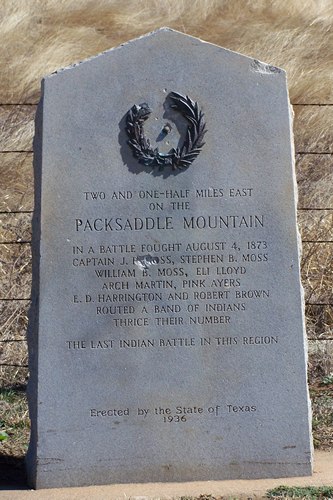Packsaddle Mountain Texas. (original) (raw)

The Mountain:
Named after the saddle-like appearance provided by twin peaks, it�s famous for the region�s last Battle with Indians in 1873. It is thought that the Spanish mined the mountain for gold prior to the Texas Revolution and that the site was perhaps Jim Bowie�s famous lost mine (see Calf Creek). Prospectors searched the area as late as the 1920s.

The Battle:
August 5, 1873. A raiding party of what was thought to be Apache Indians came down the South Llano river stealing horses and raiding farms. This wasn�t the first time. For ten years the settlers had been victims of these raiding parties. This particular band of some 20-25 Indians were followed by locals (names are shown on the marker) until the settlers could find the ideal site to attack.
After 25 miles, the Indians had stopped to cure some meat and were attacked on the top of the mountain. The casualty report was three Indians dead, while four of the pursuers were merely wounded.
The fight itself was mild compared to more well-known confrontations with Indians and may have been forgotten if it hadn�t occurred where it did.
On the anniversary of the event in 1938, descendants of the participants (the Indians either weren�t invited or had previous commitments) placed a granite marker on the site. An earlier roadside marker had been placed by the Llano County Historical Committee for the Texas Centennial in 1836.

Packsaddle Mountain Texas Centennial Marker
near intersection of SH 71 and CR 309
Photo courtesy Ernie Wymer, February 2008
1936 Centennial - Highway Marker
Packsaddle Mountain
Two and one half miles east on the Packsaddle Mountain, in a battle fought August 4, 1873, Captain J. R. Moss, Stephen B. Moss, William B. Moss, Eli Lloyd, Arch Martin, Pink Ayers, E. D. Harrington and Robert Brown routed a band of Indians thrice their number. The last Indian battle in this region.